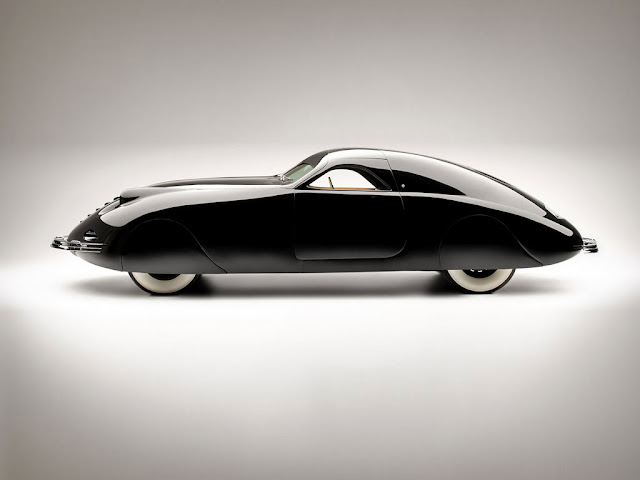I have this subject bookmarked in my browser for so long... Since 2012 to be exact. So I'm just going to post the original Sunday Slacker Magazine article, since it has everything from history to tech infos. Why re-chew some already well said words, right ?
One thing is for sure... From the razor blade looking front bumper to the Stingray shape and look, the 1938 Phantom Corsair is seductively sinister. And beautiful. Plus I'll add some extra, very nice, photos. Enjoy.
The Phantom Corsair’s steel-and-aluminum body measured just 57 inches in height and incorporated fully skirted wheels and completely flush fenders while forgoing running boards. The car also lacked door handles, as the doors were instead opened electrically using push-buttons located on the exterior and the instrument panel. The instrument panel also featured a compass and altimeter, while a separate console above the windshield indicated when a door was ajar or if the car’s lights or radio were turned on. The Corsair’s body was mated to a Cord 810, the most advanced chassis available in the United States at that time.
''The Lycoming 80º V8-powered Cord chassis also featured front-wheel drive and an electrically operated four-speed automatic gearbox, as well as fully independent suspension and adjustable shock absorbers. Though these features from the Cord 810 chassis were all retained on the Phantom Corsair, the chassis was modified in order to accommodate the Corsair’s large body. The body measured an impressive 237 inches long and 76.5 inches wide, enough to accommodate four people in the front row, including one person to the left of the driver. The back seats could only hold two passengers, however, in large part because of space limitations posed by on-board beverage cabinets. Though weighing a hefty 4,600 lb, the Phantom Corsair could achieve speeds of up to 115 mph because of its modified, naturally aspirated 190 bhp Lycoming engine as well as its aerodynamic shape.
The Phantom Corsair now resides in the National Automobile Museum (also known as The Harrah Collection) in Reno, Nevada.''
Original Sunday Slacker article, here.
4th photo by Bonsai Power
Original selling ad via Hemmings blog
Artwork (last photo) by Anton Kroshechkin










No comments:
Post a Comment
Note: Only a member of this blog may post a comment.